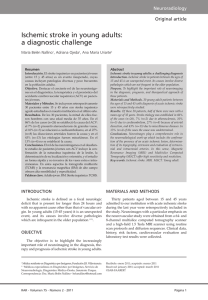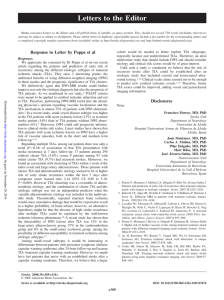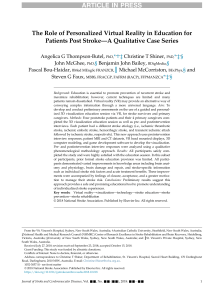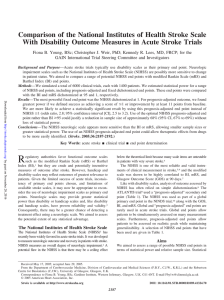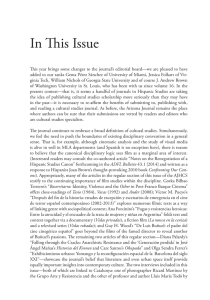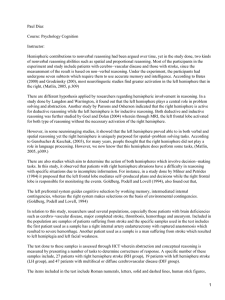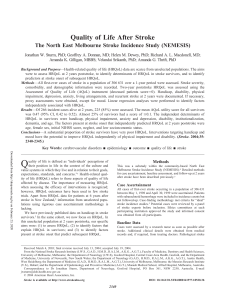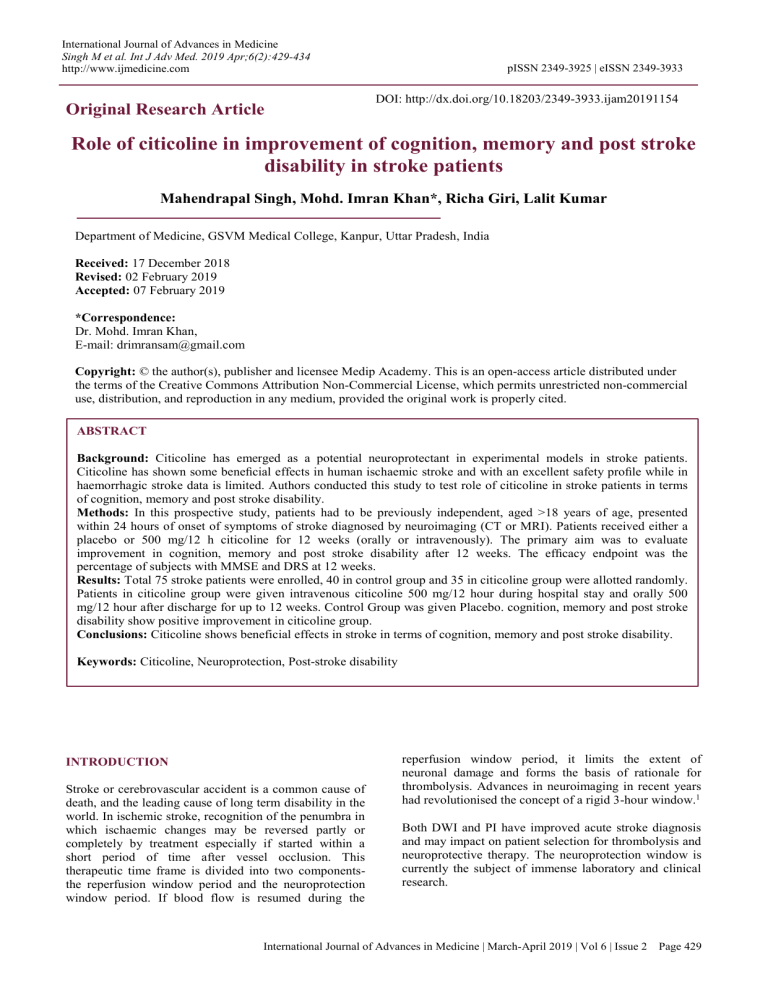
International Journal of Advances in Medicine
Singh M et al. Int J Adv Med. 2019 Apr;6(2):429-434
http://www.ijmedicine.com
Original Research Article
pISSN 2349-3925 | eISSN 2349-3933
DOI: http://dx.doi.org/10.18203/2349-3933.ijam20191154
Role of citicoline in improvement of cognition, memory and post stroke
disability in stroke patients
Mahendrapal Singh, Mohd. Imran Khan*, Richa Giri, Lalit Kumar
Department of Medicine, GSVM Medical College, Kanpur, Uttar Pradesh, India
Received: 17 December 2018
Revised: 02 February 2019
Accepted: 07 February 2019
*Correspondence:
Dr. Mohd. Imran Khan,
E-mail: drimransam@gmail.com
Copyright: © the author(s), publisher and licensee Medip Academy. This is an open-access article distributed under
the terms of the Creative Commons Attribution Non-Commercial License, which permits unrestricted non-commercial
use, distribution, and reproduction in any medium, provided the original work is properly cited.
ABSTRACT
Background: Citicoline has emerged as a potential neuroprotectant in experimental models in stroke patients.
Citicoline has shown some beneficial effects in human ischaemic stroke and with an excellent safety profile while in
haemorrhagic stroke data is limited. Authors conducted this study to test role of citicoline in stroke patients in terms
of cognition, memory and post stroke disability.
Methods: In this prospective study, patients had to be previously independent, aged >18 years of age, presented
within 24 hours of onset of symptoms of stroke diagnosed by neuroimaging (CT or MRI). Patients received either a
placebo or 500 mg/12 h citicoline for 12 weeks (orally or intravenously). The primary aim was to evaluate
improvement in cognition, memory and post stroke disability after 12 weeks. The efficacy endpoint was the
percentage of subjects with MMSE and DRS at 12 weeks.
Results: Total 75 stroke patients were enrolled, 40 in control group and 35 in citicoline group were allotted randomly.
Patients in citicoline group were given intravenous citicoline 500 mg/12 hour during hospital stay and orally 500
mg/12 hour after discharge for up to 12 weeks. Control Group was given Placebo. cognition, memory and post stroke
disability show positive improvement in citicoline group.
Conclusions: Citicoline shows beneficial effects in stroke in terms of cognition, memory and post stroke disability.
Keywords: Citicoline, Neuroprotection, Post-stroke disability
INTRODUCTION
Stroke or cerebrovascular accident is a common cause of
death, and the leading cause of long term disability in the
world. In ischemic stroke, recognition of the penumbra in
which ischaemic changes may be reversed partly or
completely by treatment especially if started within a
short period of time after vessel occlusion. This
therapeutic time frame is divided into two componentsthe reperfusion window period and the neuroprotection
window period. If blood flow is resumed during the
reperfusion window period, it limits the extent of
neuronal damage and forms the basis of rationale for
thrombolysis. Advances in neuroimaging in recent years
had revolutionised the concept of a rigid 3-hour window.1
Both DWI and PI have improved acute stroke diagnosis
and may impact on patient selection for thrombolysis and
neuroprotective therapy. The neuroprotection window is
currently the subject of immense laboratory and clinical
research.
International Journal of Advances in Medicine | March-April 2019 | Vol 6 | Issue 2
Page 429
Singh M et al. Int J Adv Med. 2019 Apr;6(2):429-434
Intracerebral haemorrhage (ICH) has a worse prognosis
than cerebral infarction.2 In general, the treatment of ICH
is controversial and the role of surgery still remains
unclear.2,3 There is some evidence that brain ischaemia
plays a role in the secondary brain injury seen in some
experimental models of the ICH neurological
deterioration occurs in 23% of ICH cases, and its
presence results in a worse prognosis.4,5
Neuroprotective therapy is directed at these biochemical
events that occur consequent to arterial occlusion.
Numerous preclinical studies in animal models of global
and focal ischaemia had shown efficacy by targeting each
of the steps along this ischaemic cascade.6 Citicoline is a
neuroprotectant drug with positive effects in experimental
models and in the treatment of the acute phase of cerebral
ischaemia, showing, in some cases, a significant
reduction in the volume of cerebral infarction.7-10
Citicoline also has a positive effect on brain oedema and
in ICH models.7,11,12 In these models, citicoline reduced
the volume of the ischaemic lesion associated with the
haematoma.
disability. The "Level of Functioning" item is the
modification of a measure used by Scranton and reflects
handicap, as does the last item, Employability.15
Subject characteristics
Subjects were more than 18 years of age and had to be
admitted within 24 hours after the onset of symptoms of
stroke diagnosed by neuroimaging (CT or MRI).
METHODS
Baseline severity was defined as patients with a score
larger than 3 points on the Glasgow Coma Scale and
larger than 7 on the National Institutes of Health Stroke
Scale (NIHSS), Written informed consent was taken.
Exclusion criteria were as follows-patients presenting
with GCS score of <3, CT or conventional MRI evidence
of brain tumour, cerebral oedema with a clinically
significant mass midline shift with compression of
ventricle, and brainstem, History of ventricular
dysrhythmia, acute myocardial infarction within 72 hours
prior to enrolment, unstable angina, decompensated
congestive heart failure, Drug addiction like cocaine,
amphetamine and expectancy of life less than 3 months
due to comorbidity.
Research design
Study treatment
The present study was prospective study single centred
conducted in the KPS institute of medicine, GSVM
Medical College Kanpur (Tertiary centre) during January
2010 to September 2011. Patients were randomly
assigned to control or citicoline group. This study
received approval from ethics committee of this institute.
For randomisation a table of random digits was used.
Both, the placebo and the active drug ampoules were
completely indistinguishable to the patients. The
treatment schedule was 500 mg intravenous citicoline or
a placebo every 12 h during hospitalisation and orally
500 mg every 12 hourly at the time of discharge and
onwards. The total time of treatment was 12 weeks.
Study instrument
Outcome measures
Improvement in the clinical profile, disability and
cognitive improvement was assessed by using Mini
Mental Status examination (MMSE) and Glasgow Coma
Scale (GCS) at the time of admission and during follow
up.
Disability was graded by using Disability Rating Scale
(DRS). The Disability Rating Scale (DRS) was developed
and tested with older juvenile and adult individuals with
moderate and severe traumatic brain injury (TBI) in an
inpatient rehabilitation setting. One advantage of the DRS
is its ability to track an individual from coma to
community. DRS score ranges from 0-29.
A person without disability scores 0 and score 29
indicates extreme vegetative state. Measurement across a
wide span of recovery is possible because various items
in this scale address all three World Health Organization
categories: impairment, disability and handicap.13 The
first three items of the DRS ("Eye Opening,"
"Communication Ability" and "Motor Response") are a
slight modification of the Glasgow Coma Scale and
reflect impairment ratings.14 Cognitive ability for
Feeding, Toileting and Grooming reflect level of
The primary endpoint was effectiveness. The
effectiveness of the treatment was assessed in terms of
improvement in cognition, memory and reduction in the
post stroke disability. The efficacy endpoint was assessed
using Disability Rating Scale (DRS) at 3 months. NIHSS
scores were measured at baseline and week 12.
Statistical analysis
The monitoring of the study, the data management, and
the statistical analysis was done using SPSS software.
Statistical analysis was conducted according to the
intention to treat principle. The intention-to-treat
population was defined as patients randomised with at
least one efficacy evaluation after receiving at least one
medication dose, and fulfilling inclusion and exclusion
criteria of this study. All comparisons with these
variables were conducted using the chi square test. The
descriptive and clinical variables were analysed at
baseline to maintain homogeneity between groups. For
the analysis of ordinal variables, we used non-parametric
statistical tests. Values of p <0.05 were considered
significant.
International Journal of Advances in Medicine | March-April 2019 | Vol 6 | Issue 2
Page 430
Singh M et al. Int J Adv Med. 2019 Apr;6(2):429-434
RESULTS
This study was conducted on 75 patients of
cerebrovascular
accident
including
ischemic,
haemorrhagic and subarachnoid haemorrhage, with
proven CT/MRI of head compatible with finding of
stroke. but 11 patients (5 from citicoline group and 6
from control group) did not turned for follow up so we
can’t assess what happened to them whether improved or
died.
Table 1: Demographic profile, baseline characteristics
and risk factors.
Parameters
Age (in years)
<40 years
40-60 years
>60 years
Sex
Male
Female
Risk factors
Hypertension
Diabetes
Smoking
Dyslipidemia
Alcoholism
Cardiac disease
Past history of
TIA/Stroke
Types of stroke
Ischemic
Haemorrhagic
Subarachnoid
Placebo
(n=40)
Citicoline
(n=35)
6 (15%)
10 (25%)
24 (60%)
4 (11.5%)
9 (25.7%)
22 (62.8%)
25 (62.5%)
15 (37.5%)
24 (68.5%)
11 (31.5%)
20 (50%)
10 (25%)
10 (25%)
8 (20%)
7 (17.5%)
8 (20%)
22 (62.8%)
8 (22.9%)
9 (25.7%)
7 (20%)
6 (17.1%)
5 (14.3%)
9 (22.5%)
9 (25.7%)
27 (67.5%)
9 (22.5%)
4 (10%)
23 (65.7%)
10 (28.6%)
2 (5.7%)
Mean age of onset of stroke was 62.5 years in this study,
61.3% of patients in our study were more than 60 years of
age (Table 1). Incidence of stroke were higher as age of
patient increases. In this study stroke was more prevalent
in male (65.3%) as compared to female (34.7%) (Table
1). In present study 65.7 % patients have ischemic stroke
while 28.6% patients have haemorrhagic stroke which is
higher than previously reported it may due poor
compliance to antihypertensive drug or small study
sample while 48.5% patients presented with headache or
coma. 37.1% presented with vomiting especially in those
patients who had intracerebral haemorrhage, SAH or
large infarct and oedema (Table 1). 85.3% patients
present with right sided hemiparesis while 37.4% have
left sided hemiparesis. Left sided lesion was more
common in patients of cognitive impairment due to
stroke. Decreased level of consciousness was present in
65.9% of our cases (in which 37.4% were drowsy and
25.7% were comatose). Decreased level of consciousness
created the problem in scoring of MMSE. A slightly
higher percentage of decreased level of consciousness
might be due to delay in seeking treatment.
In the present study 43.1% patients present with aphasia
(in which 25% in control group and 18.1% in study
group. Aphasia created the problem in scoring MMSE
and DRS of patients despite being conscious.
The average Mini Mental Score (MMSE) of control
group improved from 15±6.0 on admission to 17.6 ±6.55
at 12 weeks (t=2.0 and p<0.05).while in citicoline group
MMSE shows statistically significant improvement
{12.34±7.2 on admission and 18.7±6.6 at 12 weeks
(t=5.6, p<0.001)}.MMSE was 5-19 range in 64% in
control group (64% have cognitive impairment) 8.8%
patient have normal cognition at 12 weeks. While in
citicoline group 83% patients have MMSE in 5-19
range,13.3% patients have normal cognition at 12 weeks
(Table 2).
Average disability rating score (DRS) of control group
was 13.8±7.3 on admission and 10.9±7.2 at 12 weeks
(t=2.30 and p<0.05). 8.8% of control group having DRS
near normal at admission which improved to 20.6% at 12
weeks. In citicoline group DRS on admission was
11.4±6.8 and 7.8±7.2 (t=2.69, p<0.05) at 12 weeks which
shows positive impact in disability improvement (Table
3). Authors also compared Glasgow coma scale (GCS) of
control group with the GCS of study group at admission
(x2=2.48, p>0.05). It shows favourable GCS of citicoline
group as compared to control group but not statistically
significant. But Glasgow Coma Scale is not a good to
assess the effect of citicoline.
Table 2: Results of memory and cognition at admission and 12 weeks.
MMSE
0-4
5-9
10-14
15-19
20-24
25-30
Placebo
At admission
2 (5.8%)
3 (8.8%)
9 (26.5%)
13 (38.2%)
5 (14.7%)
2 (5.8%)
12 weeks
3 (8.8%)
5 (14.7%)
7 (20.5%)
10 (29.4%)
6 (17.6%)
3 (8.8%)
Citicoline
At admission
4 (13.3%)
6 (20%)
8 (26.7%)
6 (20%)
5 (16.7%)
1 (3.3%)
12 weeks
1 (3.3%)
3 (10%)
5 (16.7%)
8 (26.7%)
9 (30%)
4 (13.3%)
International Journal of Advances in Medicine | March-April 2019 | Vol 6 | Issue 2
Page 431
Singh M et al. Int J Adv Med. 2019 Apr;6(2):429-434
Table 3: Results of post-stroke disability at admission and 12 weeks.
DRS
0-1
2-3
4-6
7-11
12-16
17-21
22-24
25-29
Placebo
At admission
1 (2.9%)
2 (5.8%)
4 (11.8%)
6 (17.6%)
8 (23.5%)
5 (14.7%)
5 (14.7%)
3 (8.8%)
Citicoline
At admission
1 (3.3%)
2 (6.6%)
6 (20%)
7 (23.3%)
8 (26.6%)
3 (10%)
2 (6.6%)
1 (3.3%)
12 weeks
3 (8.8%)
4 (11.8%)
6 (17.6%)
8 (23.5%)
5 (14.7%)
3 (8.8%)
2 (5.8%)
3 (8.8%)
DISCUSSION
Neuroprotection is an emerging concept in stroke
patients. Optimal treatment for ICH is controversial, use
of citicoline to ‘protect’ the brain against the ischaemic
insult observed in these cases.3 Mean age of onset of
stroke in India ranges from 63-65 years for men and 5768 years for women.16 Age specific stroke was higher for
all age group in men.17
In an Indian study found male to-female ratio 1.7 in
stroke patient, which was similar to our study (1.8:1).18 It
should be considered that the pathophysiology of cerebral
injury after ICH shares several mechanisms with
ischaemic injury.19-23 So, there may be an option to the
use of neuroprotectant (like citicoline in this study).
Up to now, the efficacy and safety of neuroprotectant
drugs has only been tested in patients with ICH in
subgroup analyses from the CLASS study and from the
GAIN studies.24-26 In the CLASS study it was
demonstrated that clomethiazole was safe, but there was
no evidence of efficacy due to the small sample size.
In addition, the GAIN studies did not show positive
results for acute ischaemic stroke patients.27,28 In our
case, we studied the effects of citicoline on the outcome
of patients with stroke.
Citicoline is a drug with some evidence of effectiveness
in the treatment of acute ischaemic stroke.12,18,19
Citicoline is a very safe drug in acute ischaemic stroke
patients.29 The International Citicoline Trial on Acute
Stroke, ICTUS was designed to confirm the encouraging
results of the data pooling analyses and to replicate those
trends.29
ICTUS was an international, multicentre, prospective,
double-blind, randomized, placebo-controlled trial with
participation of neurology services from 37 centres.
Mortality was comparable between the two groups.
Global recovery at 90 days was similar in patients who
received citicoline and in those who received placebo.
Citicoline is safe but does not provide efficacy evidence
12 weeks
4 (13.3%)
5 (16.7%)
9 (30%)
4 (13.3%)
4 (13.3%)
2 (6.6%)
1 (3.3%)
1 (3.3%)
for the treatment of moderate-to-severe acute ischemic
stroke. Citicoline at high doses is as effective as i.v.
thrombolysis in experimental stroke.30
The results of current study, despite limitations
concerning the sample size and statistical significance,
are similar to those seen in other ischaemic stroke studies.
Present study data shows a positive trend in favour of
citicoline in comparison with placebo as regards to the
cognition, memory and post stroke disability.
Limitations of study was single centre study having small
study population. The stroke pathogenesis involve
various pathway of neuronal injury so single drug may
not be effective neuroprotection at all pathways.
Decreased level of consciousness and aphasia in
otherwise conscious patients was problematic in scoring
of MMSE.
CONCLUSION
Citicoline established as a neuroprotectant in various
studies. In present study citicoline has a positive effect in
stroke patients in terms of cognition and post stroke
disability. Larger clinical studies to be needed to
generalise this study results in the population.
ACKNOWLEDGEMENTS
Authors express their gratitude from participants in this
study as well as Dr. Dipti Lodhi and Samreen Imran to
support this study.
Funding: No funding sources
Conflict of interest: None declared
Ethical approval: The study was approved by the
Institutional Ethics Committee
REFERENCES
1.
Fisher M, Albers GW. Applications of diffusion–
perfusion magnetic resonance imaging in acute
ischemic stroke. Neurol. 1999 Jun 1;52(9):1750.
International Journal of Advances in Medicine | March-April 2019 | Vol 6 | Issue 2
Page 432
Singh M et al. Int J Adv Med. 2019 Apr;6(2):429-434
2.
3.
4.
5.
6.
7.
8.
9.
10.
11.
12.
13.
14.
15.
16.
Kase CS. Intracerebral haemorrhage. Bailliere's Clin
Neurol. 1995 Aug;4(2):247-78.
Mendelow AD, Gregson BA, Fernandes HM,
Murray GD, Teasdale GM, Hope DT, et al. Early
surgery versus initial conservative treatment in
patients
with
spontaneous
supratentorial
intracerebral haematomas in the International
Surgical Trial in Intracerebral Haemorrhage
(STICH): a randomised trial. Lancet. 2005 Jan
29;365(9457):387-97.
Gong C, Boulis N, Qian J, Turner DE, Hoff JT,
Keep RF. Intracerebral hemorrhage-induced
neuronal death. Neurosurg. 2001 Apr 1;48(4):87583.
Leira RM, Davalos AM, Silva Y, Gil-Peralta AM,
Tejada JM, Garcia MM, et al. Early neurologic
deterioration in intracerebral hemorrhage: predictors
and associated factors. Neurol. 2004 Aug
10;63(3):461-7.
DeGraba TJ, Pettigrew LC. Why do neuroprotective
drugs work in animals but not humans?. Neurol
Clin. 2000 May 1;18(2):475-93.
Secades JJ. CDP-choline: update and review of its
pharmacology and clinical use. Methods Find Exp
Clin Pharmacol. 2002; 24(suppl B):1-53.
Saver JL, Wilterdink J: Choline precursors in acute
and subacute human stroke: a meta-analysis. Stroke
2002;33(1):353.
Dávalos A, Castillo J, Álvarez-Sabín J, Secades JJ,
Mercadal J, López S, et al. Oral citicoline in acute
ischemic stroke: an individual patient data pooling
analysis of clinical trials. Stroke. 2002 Dec
1;33(12):2850-7.
Warach S, Harnett K. Dose dependent reduction in
infarct growth with citicoline treatment: evidence of
neuroprotection in human stroke? Stroke.
2002;33(1): 354.
Kase M, Ono J, Yoshimasu N, Hiyamuta E, Sugiura
K. Effect of CDP-choline in experimental cerebral
hemorrhage. Curr Therapeut Res Clin Experiment.
1974 May;16(5):483-502.
Clark W, Gunion-Rinker L, Lessov N, Hazel K.
Citicoline treatment for experimental intracerebral
hemorrhage in mice. Stroke. 1998 Oct 1;29:2136-9.
World Health Organization-WHO. International
Classification of Functioning, Disability and HealthICF.
Geneva:
WHO;2001.
Available
at:
https://www.who.int/classifications/icf/en/
Teasdale G, Jennett B. Assessment of coma and
impaired consciousness: a practical scale. Lancet.
1974 Jul 13;304(7872):81-.
Scranton J, Fogel ML, Erdman 2nd WJ. Evaluation
of functional levels of patients during and following
rehabilitation. Arch Physical Med Rehab. 1970
Jan;51(1):1.
Bhattacharya S, Saha SP, Basu A, Das SK. A 5
years prospective study of incidence, morbidity and
mortality profile of stroke in a rural community of
eastern India. J Indian Med Assoc. 2005
Dec;103(12):655-9.
17. Sacco RL, Kargman DE, Gu Q, Zamanillo MC.
Race-ethnicity and determinants of intracranial
atherosclerotic cerebral infarction: the Northern
Manhattan Stroke Study. Stroke. 1995 Jan;26(1):1420.
18. Banerjee TK, Das SK. Epidemiology of stroke in
India. Neurol Asia. 2006 Jun;11:1-4.
19. Gong C, Boulis N, Qian J, Turner DE, Hoff JT,
Keep RF. Intracerebral hemorrhage-induced
neuronal death. Neurosurgry. 2001 Apr 1;48(4):87583.
20. Andaluz N, Zuccarello M, Wagner KR.
Experimental animal models of intracerebral
hemorrhage. Neurosurg Clin North Am. 2002
Jul;13(3):385-93.
21. Belayev L, Saul I, Curbelo K, Busto R, Belayev A,
Zhang Y, et al. Experimental intracerebral
hemorrhage in the mouse: histological, behavioral,
and hemodynamic characterization of a doubleinjection model. Stroke. 2003 Sep 1;34(9):2221-7.
22. Castillo J, Davalos A, Álvarez–Sabín J, Pumar JM,
Leira R, Silva Y, Montaner J, Kase CS. Molecular
signatures of brain injury after intracerebral
hemorrhage. Neurol. 2002 Feb 26;58(4):624-9.
23. Fatar M, Stroick M, Griebe M, Hennerici MG.
Matrix metalloproteinases in cerebrovascular
diseases. Cerebrovasc Dis. 2005;20(3):141-51.
24. Wahlgren NG, Diez-Tejedor E, Teitelbaum J,
Arboix A, Leys D, Ashwood T, et al. Results in 95
hemorrhagic stroke patients included in CLASS, a
controlled trial of clomethiazole versus placebo in
acute stroke patients. Stroke. 2000 Jan;31(1):82-5.
25. Lyden P, Shuaib A, Ng K, Levin K, Atkinson RP,
Rajput A, Wechsler L, Ashwood T, Claesson L,
Odergren T, Salazar-Grueso E. Clomethiazole acute
stroke study in ischemic stroke (CLASS-I). Stroke.
2002;33(1):122-9.
26. Haley Jr EC, Thompson JL, Levin B, Davis S, Lees
KR, Pittman JG, DeRosa JT, et al. Gavestinel does
not improve outcome after acute intracerebral
hemorrhage: an analysis from the GAIN
International and GAIN Americas studies. Stroke.
2005 May 1;36(5):1006-10.
27. Lees KR, Asplund K, Carolei A, Davis SM, Diener
HC, Kaste M, et al. Glycine antagonist (gavestinel)
in neuroprotection (GAIN International) in patients
with acute stroke: a randomised controlled trial.
Lancet. 2000 Jun 3;355(9219):1949-54.
28. Sacco RL, DeRosa JT, Haley Jr EC, Levin B,
Ordronneau P, Phillips SJ, et al. Glycine antagonist
in neuroprotection for patients with acute stroke:
GAIN Americas: a randomized controlled trial.
JAMA. 2001 Apr 4;285(13):1719-28.
29. Dávalos A, Castillo J, Álvarez-Sabín J, Secades JJ,
Mercadal J, López S, Cobo E, et al. Oral citicoline
in acute ischemic stroke: an individual patient data
pooling analysis of clinical trials. Stroke. 2002 Dec
1;33(12):2850-7.
30. Gutiérrez-Fernández M, Leciñana MA, RodríguezFrutos B, Ramos-Cejudo J, Roda JM, Díez-Tejedor
International Journal of Advances in Medicine | March-April 2019 | Vol 6 | Issue 2
Page 433
Singh M et al. Int J Adv Med. 2019 Apr;6(2):429-434
E. CDP-choline at high doses is as effective as iv
thrombolysis in experimental animal stroke.
Neurological research. 2012 Sep 1;34(7):649-56.
Cite this article as: Singh M, Khan MI, Giri R,
Kumar L. Role of citicoline in improvement of
cognition, memory and post stroke disability in
stroke patients. Int J Adv Med 2019;6:429-34.
International Journal of Advances in Medicine | March-April 2019 | Vol 6 | Issue 2
Page 434
